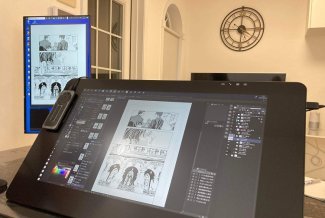The strong showing by Democrats in the recent mid-term elections in the United States – the so-called ‘blue wave’ – ended the conservative stranglehold on government. Democrats regained control of the House of Representatives and won key races, especially in the industrial Midwest. But even more important than the election wave may be an emerging ‘class wave’ identified by Working America, the community affiliate of the AFL-CIO that has been organising in working- class communities among people who don’t have a union for the last 15 years. The ‘class wave’ can be seen in the elections and creates an opportunity for new union organising.
Democrats won races throughout the Midwest, with voters getting rid of virulently anti-labour governors in Wisconsin and Illinois, defeating the hard-line anti-immigrant Trump mouthpiece running for governor in Kansas, and voting for Democrats to win key elections in Pennsylvania, Michigan, Ohio, Minneapolis and Iowa. In 2016, enough white working-class voters in these states helped throw the election to Donald Trump. This year, many switched their vote again.
Voting against Donald Trump motivated committed Democrats, but swing voters were focused on improving their immediate lives. Health care, education and infrastructure were top issues. Michigan governor-elect Gretchen Whitmer’s campaign slogan, “Fix the damn roads”, captured this concern and put her over the top. Even low unemployment and a tax cut didn’t assuage these anxious voters.
According to exit polls, eight per cent of Trump voters voted for Democrats for Congress, with health care as a top issue. Amongst those canvassed by Working America, concerns about health care have almost tripled since 2012, and those who ranked health care a top priority voted for Democrats over Republicans by 42 points.
An astonishing 38 per cent of Working America members who voted for Trump in 2016 voted for Democrats for Congress this year, suggesting that long-term engagement with working-class swing voters elevates the draw of pocket-book issues over racist, anti-immigrant fear-mongering.
The restlessness in political alignment tracks a change amongst working people about their status and collective power. Working America organisers see a new attitude about jobs and unions, which I describe in my American Prospect article Class Consciousness Comes to America. People who used to think of themselves as middle-class find themselves struggling to make ends meet, while blue-collar workers find a new appeal in collective power after 40 years wandering in the desert of “you’re on your own.” A Gallup poll taken this summer found union approval at 62 per cent – the highest it’s been in 15 years.
This is significant. Unlike Europe, a basic understanding and recognition of class differences has been resisted in the US, even by liberal thinkers and writers. We were supposed to be an overwhelmingly middle-class society, a notion reinforced by the economic success of the post-World War II economy. Class, it was argued, was an outworn, European view that had no relevance to the American experience. As a consequence of two generations of neoliberalism, the economic recession of 2008, and a chasm of income inequality, American working people are rethinking their place in society.
“Unions would make the employers pay”
Take 23-year-old Tom who does low-wage landscape work in central Ohio and doesn’t get paid if it rains. He blames young people, like his cousins, for being lazy, but also knows that employers get away with whatever they can. “I’d love to be in a union,” he says. “I’m fine paying dues – I’d be making more money. Unions would make the employers pay.”
His neighbour across the street, Carol, has been a nurse for a dozen years. She has a good job with good pay, but it still isn’t enough to keep up with the cost of living. How does she see herself? “Working-class, definitely.”
White collar workers like Carol find themselves economically squeezed, often taking second jobs in the blue-collar workforce, such as in retail or as Uber drivers. They see common ground with blue-collar workers who are once again looking to unions for power. And we’re seeing an upsurge in action directed at employers throughout the workforce.
Tens of thousands of teachers went on strike this year, white-collar warriors in conservative states, fed up with low pay and schools starved of resources. Low-wage workers have been mobilising for higher pay and union contracts in the fast food industry under the banner ’Fight for $15.’
Amongst the young, support for unions is particularly strong; a recent Pew poll showed that 68 per cent of Americans under 30 have favourable views of unions – a sentiment reflected in the unionisation campaigns of graduate students and the young journalists at new media outlets. Even high-paid workers are getting in on the act, as Google employees protested the company’s sexual harassment policies with a global walkout.
The key is to turn this anger into self-sustaining worker organisations in the face of massive attacks on unions and hostile labour laws which constrain representation. Unions are stepping up their organising, both amongst their current members and creating new strategies and forms of representation to bring in new members. In the long run, building strong unions will do more for democracy in the US than any wave election. The best antidote to the chaotic politics of right-wing populism is cross-class, multi-racial democratic worker organisations where people can mediate their differences, and find the strength together to challenge the real powers that be.









